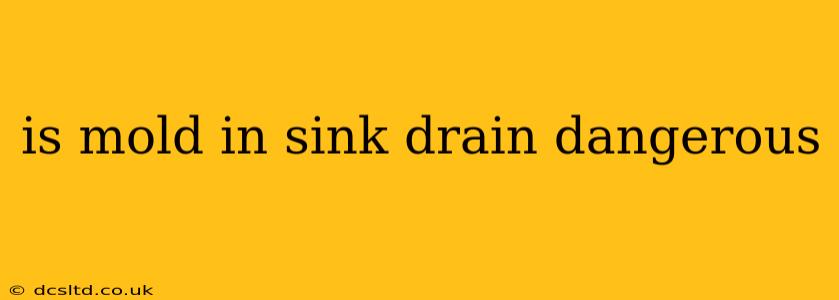Mold in your sink drain might seem like a minor inconvenience, but it's crucial to understand the potential dangers it poses. While not all mold is inherently hazardous, the presence of mold in a consistently damp environment like a drain indicates a potential health risk and a need for remediation. This guide will explore the dangers of sink drain mold, answer frequently asked questions, and provide practical solutions.
What are the dangers of mold in a sink drain?
Mold thrives in moist, dark areas, making sink drains an ideal breeding ground. The dangers extend beyond just an unpleasant smell; various mold species produce mycotoxins, which are harmful substances that can cause a range of health problems, particularly for those with allergies or respiratory issues. Exposure to mold can trigger allergic reactions like sneezing, coughing, itchy eyes, and skin irritation. In more severe cases, it can lead to respiratory infections, headaches, and even more serious health complications, especially for individuals with compromised immune systems. The type of mold present greatly influences the severity of the health risks.
What types of mold are commonly found in sink drains?
Several mold types can colonize sink drains, with Cladosporium, Aspergillus, and Penicillium being some of the most common. These molds vary in their toxicity, but all can trigger allergic reactions. Identifying the specific mold species requires laboratory testing, which is generally not necessary unless severe health issues arise. Focusing on mold prevention and removal is the most effective approach.
How can I tell if I have mold in my sink drain?
The most obvious sign is a musty, earthy odor emanating from the drain. You might also notice slimy or discolored buildup around the drain opening. The color can vary, ranging from black and green to white or grey, depending on the mold species. If you suspect mold, a visual inspection with a flashlight can help confirm its presence. However, reaching into the drain to check for mold is not recommended due to potential exposure to harmful substances.
Is mold in a sink drain a health hazard for everyone?
While the presence of mold doesn't automatically mean severe health risks for everyone, it significantly increases the risk of developing allergic reactions or respiratory problems. Individuals with pre-existing respiratory conditions like asthma or allergies are particularly vulnerable. Children and the elderly are also at higher risk due to their less developed or weakened immune systems. Even for healthy individuals, prolonged exposure to mold can weaken the immune system and lead to various health problems over time.
How do I prevent mold growth in my sink drain?
Prevention is key to avoiding mold problems in your sink drain. Regular cleaning is essential. Use a mixture of baking soda and vinegar to deodorize and clean the drain weekly or bi-weekly. Boiling water poured down the drain can also help kill mold spores and remove debris. Ensure proper ventilation in your bathroom and kitchen to reduce moisture buildup. Keep the area around the sink dry and address any leaks promptly to eliminate mold's favorite environment. Regularly inspecting your drain for any signs of mold is crucial for early detection and intervention.
What should I do if I find mold in my sink drain?
If you discover mold in your sink drain, don't panic. The first step is to clean the drain thoroughly using a safe mold cleaner. Always follow the manufacturer’s instructions carefully. If the mold infestation is extensive or you are uncomfortable handling the cleaning process yourself, it is advisable to call a professional mold remediation service. They have specialized equipment and expertise to safely remove mold and prevent its recurrence. Remember, prevention is always better than cure. Regular cleaning and maintenance can go a long way in keeping your sink drains mold-free.
